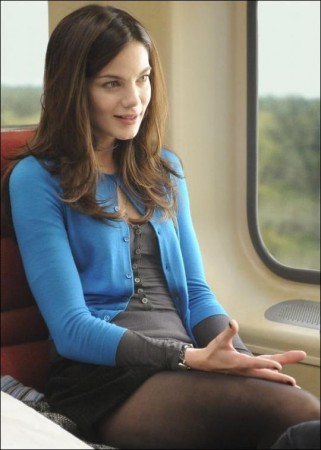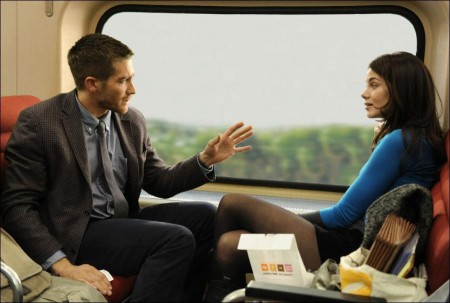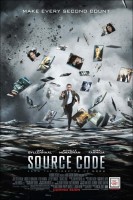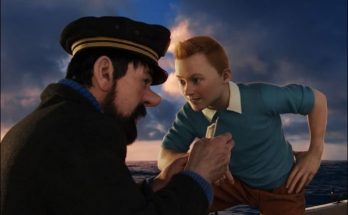Taglines: Make every second count.
When decorated soldier Captain Colter Stevens (Jake Gyllenhaal) wakes up in the body of an unknown man, he discovers he’s part of a mission to find the bomber of a Chicago commuter train. In an assignment unlike any he’s ever known, he learns he’s part of a government experiment called the “Source Code,” a program that enables him to cross over into another man’s identity in the last 8 minutes of his life.
With a second, much larger target threatening to kill millions in downtown Chicago, Colter re-lives the incident over and over again, gathering clues each time, until he can solve the mystery of who is behind the bombs and prevent the next attack. Filled with mind-boggling twists and heart-pounding suspense,
Source Code is a smart action-thriller directed by Duncan Jones (Moon) also starring Michelle Monaghan (Eagle Eye, Due Date), Vera Farmiga (Up in the Air, The Departed), and Jeffrey Wright (Quantum of Solace, Syriana). Intricately plotted, visually inventive and compellingly portrayed, Source Code takes audiences into one of the last frontiers, a world that has fascinated scientists and fiction writers for centuries: time travel.
Producer Mark Gordon, whose credits include 2012 and Saving Private Ryan, was approached by screenwriter Ben Ripley with an idea about a man who discovers a way to travel back in time for short periods. “Ben came to us with a terrific idea for a film,” says Gordon. “Over a period of about six months to a year, we continued to develop the script with him. What you hope for in a collaborator is someone who has very strong opinions but at the same time will listen and consider another way of approaching it, and that’s Ben. He has strong opinions and he sticks to his guns.”
As the script evolved, it attracted the attention of Philippe Rousselet, CEO of Vendôme Pictures and a producer of Source Code. “We loved the script,” says Rousselet. “It’s rare to find a unique story that is commercial at the same time. It’s an intelligent and sophisticated thriller, and yet it’s very entertaining. Things are revealed to the audience as they are revealed to the characters, which makes it a fun ride. It’s not every day we have a chance to read a script like that.”
Ripley’s idea was a nonlinear story with a science-fiction twist. “I’m fascinated by movies that tell a story in a nontraditional way,” he says. “It occurred to me that the first experiments in time travel wouldn’t be massively ambitious. We wouldn’t go back hundreds of years; we’d go back minutes or hours. You can imagine this technology emerging almost by accident in a research laboratory somewhere and then being taken over by the Department of Defense. They don’t really know what to do with it. It’s still experimental. The fact that he has only eight minutes to complete his mission lends urgency to it because there is a limit on the information he was able to collect.”
The screenwriter is willing to entertain the possibility that time travel will be possible someday. “Most of the time travel scientists like to talk about is future time travel,” he says. “We may be able to slow down your clock when you’re traveling close to the speed of light, which would allow you to move into the future. Time travel into the past is much more problematic and we don’t really know how that would work. The past is unchangeable according to physics. What it does propose is the idea of a parallel universe, a copy of reality that’s identical to ours. Source Code is the ability to access another reality for an eight-minute period of time.”
After developing the script with Ripley, Gordon sent it to actor Jake Gyllenhaal, who signed on to play Captain Colter Stevens. “Jake and I did The Day After Tomorrow together,” says Gordon. “We stayed in touch and were looking for another picture we could do together. He was very excited about this script and had a lot of valuable insights. Jake was a very important part of this movie coming together.”
Almost all of the film’s action takes place on a train headed for Chicago filled with commuters who make this trip this daily. But for one of those commuters, this is anything but an ordinary day. Colter Stevens, a Blackhawk helicopter pilot in the US Army, is there on an astonishing assignment. “He finds himself on a train one morning not knowing where he is or how he got there,” says Gyllenhaal. “Sitting across from him is a woman, Christina, who acts as if she knows him. He’s pretty disoriented. Then in the reflection of a window he sees his face—only it’s not his face.”
In a matter of minutes, Colter soon discovers that he has been transported to the train from a few hours in the future. “Even to the characters in this movie, the source code technology is not entirely known,” says Ripley. “What happens to the Source Code world when we leave it? We don’t know. Did it ever exist before we accessed it, or did we create it? We don’t know.”
Gyllenhaal, who also starred in the time-travel cult classic, Donnie Darko, was intrigued by the premise, as well as the acting challenges inherent in his character’s predicament. “I’m fascinated by the concept of time, so I loved mining that stuff,” says the actor. “There was a lot for me to take in, especially in pre-production, in order to understand Colter. His overall arc keeps coming back to the eight minutes that he lives over and over again.”
After signing on as leading man, Gyllenhaal suggested to the producers that they approach director Duncan Jones, whose first film, Moon, made a big impression on the actor. “Moon was stunning from the first frame to the last,” he says. “As I watched, it became so clear that Duncan is fluent in the language of film. His storytelling is so agile that I immediately wanted to work with him.”
Gordon screened Moon and met with Duncan Jones on Gyllenhaal’s recommendation. “He was able to use one space and one actor so beautifully in Moon,” says Gordon. “Even though a great deal of our film takes place on a train car or two, it doesn’t feel claustrophobic. It feels like there’s a lot going on.”
Jones’ ability to create an original and wholly believable world for Moon was an important factor in his selection, says Rousselet. “Duncan brought his unique visual world to the project. He’s a great filmmaker and a very strong storyteller, which is exactly what Source Code needed. Duncan is as passionate about the visual as he is about the actors and the storytelling, He’s a complete filmmaker in that sense.”
There are some clear parallels to Source Code’s explorations of time, identity and humanity in Jones’ first film. “Duncan seems to be interested in altering reality a bit,” says Gyllenhaal. “At at the same time, he gets to the heart of what’s in the unconscious. In both these films, somebody is very lost at first and they have to find their way through this unfamiliar situation. They are trying to discover what they’re doing.”
Despite the accolades and attention showered on him for his earlier work, Jones was not initially eager to make another science fiction film. “But I loved the script. It was tightly written and fast moving. I’m also a huge fan of Jake Gyllenhaal. I didn’t want to pass up an opportunity to work with him.”
Once the director came onboard, he and Gyllenhaal began to hash out their ideas for the movie. Each had strong ideas about where the script was headed. “We developed an amazingly collaborative relationship,” says Jones. “We added a lot more tongue-in-cheek humor than was originally on the page and I’m pleased with that. The love story became stronger and more touching, more so than I even realized when we were shooting it.”
As tempting as it was for Jones to delve into the extensive scientific data available, he chose to concentrate on the narrative. “If I had allowed myself to get too bogged down in that side of it, it would’ve hindered the storytelling,” he says. “I have a reasonable background in philosophy and science, so it was fairly easy for me to wrap my head around what was being suggested. I understood what the rules were and how the story had to be told within those rules, but I didn’t allow myself to get stuck there.”
He concentrated instead on unraveling the story’s narrative as it evolved over the course of each source code. “The puzzle solving aspect of it was quite intriguing,” says Jones. “For example, the number of locations is very limited and they are all enclosed in one way or another. How do you make characters out of each of them so that when we return to them, they actually can sense the changes, even though they may be quite subtle? Part of the challenge was to come up with that evolution. A lot of things became clear as filming progressed.
“The beauty of the script is that there’s constantly new exploration,” adds Jones. “Colter enters each repetition, or ‘source code,’ as we call them in the film, with more knowledge. Each time he brings something new to the situation. The challenge for us was how do you keep each source code fresh and give the audience something that’s going to keep them engaged.” Source Code is a prime example of a new wave of science fiction storytelling, according to the director. “The mixture of humor and science fiction elements makes it something different and quite appealing. The audience doesn’t need to get bogged down in the logic or the science of it all. They can just go along for the ride.”
But for audiences who enjoy unraveling puzzles, the film offers plenty to ponder. “If half the audience comes away satisfied with the love story and the action, and the other half is intrigued by the ending and enjoys trying to work it all out, then I’ll be very satisfied,” says Jones. “I think there’s enough there to keep everyone engaged.”
According to Gordon, there’s another element for the audience to enjoy. “What’s special about the film is that it has an enormous amount of action and it’s a wonderful thriller,” says the producer. “It’s all things you hope for in a movie in terms of pure entertainment. But at the end of the film when the curtain comes down, so to speak, I’d like for people to walk out of the theater having enjoyed the thrills, but also thinking about how precious life is. Whether it’s eight minutes or a lifetime, it is something that you should savor. We all have bad days, but life is magnificent and beautiful. It may sound a little hokey, but I think that when you leave the film, you have a greater sense of appreciation because Jake’s character gets a second chance at life.”
Source Code
Directed by: Duncan Jones
Starring: Vera Farmiga, Jake Gyllenhaal, Michelle Monaghan, Jeffrey Wright, Russell Peters, Paula Jean Hixson, Russell Peters
Screenplay by: Ben Ripley
Production Design by: Barry Chusid
Cinematography by: Don Burgess
Film Editing by: Paul Hirsch
Costume Design by: Renée April
Set Decoration by: Josée Arsenault, Suzanne Cloutier, Sylvie Desmarais
Art Direction by: Pierre Perrault
Music by: Chris Bacon
MPAA Rating: PG-13 for disturbing images, language and some violence.
Studio: Summit Entertainment
Release Date: April 1, 2011
Hits: 200






